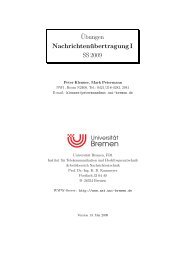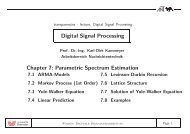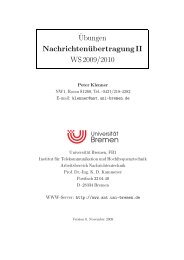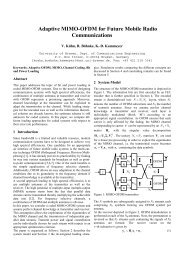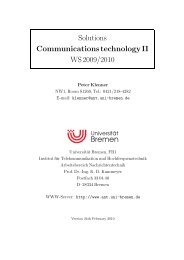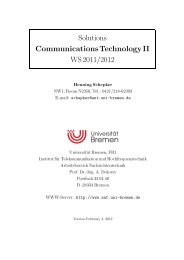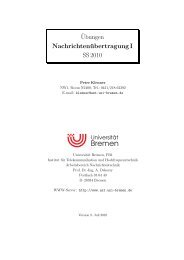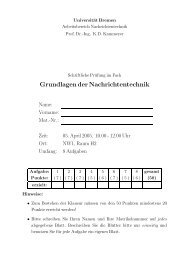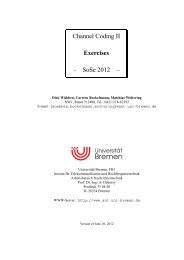Channel Coding I Exercises â WS 2012/2013 â - Universität Bremen
Channel Coding I Exercises â WS 2012/2013 â - Universität Bremen
Channel Coding I Exercises â WS 2012/2013 â - Universität Bremen
Create successful ePaper yourself
Turn your PDF publications into a flip-book with our unique Google optimized e-Paper software.
4 CONVOLUTION CODES November 7, <strong>2012</strong> 11<br />
4 Convolution codes<br />
4.1 Fundamental principles<br />
Exercise 4.1<br />
Convolution code<br />
Given is a convolution code with the code rateR = 1/3, memorym = 2 and the generator polynomials<br />
g 1 (D) = 1+D +D 2 and g 2 (D) = 1+D 2 and g 3 (D) = 1+D +D 2 .<br />
a) Determine the output sequence for the input sequence u = (011010).<br />
b) Sketch the corresponding Trellis chart in the case of the under a) given input sequence.<br />
c) Sketch the state diagram of the encoder.<br />
d) Determine the corresponding free distance d f .<br />
4.2 Characterization of convolution codes<br />
Exercise 4.2<br />
Catastrophic codes<br />
Given is the convolution code with the generator polynomial g(D) = (1+D 2 ,1+D). Show that this<br />
is a catastrophic code and explain the consequences.<br />
4.3 Distance properties of convolution codes<br />
Exercise 4.3<br />
Distance properties of convolution codes<br />
a) Given is the non-recursive convolution code with the generatorsg 0 (D) = 1+D+D 3 andg 1 (D) =<br />
1+D+D 2 +D 3 . Determine by means of the MATLAB-routine iowef conv the IOWEF and<br />
present a w,d (in the script also called T w,d ) for even and odd input weights in separate diagrams<br />
(maximal distance d max = 20). How large is the free distance of the code and what’s striking with<br />
reference to the weight distribution?<br />
b) Calculate the coefficients a d and c d .<br />
c) Estimate the word- and bit error rates with the help of the Union Bound for the AWGN-channel<br />
in the range 0 dB ≤ E b /N 0 ≤ 6 dB. Draw the determined error rates for several maximally<br />
considered distances d.<br />
d) The convolution code shall now be terminated and considered as block code of the length n = 50.<br />
Determine the IOWEF with the function iowef block conv and calculate the bit error rate<br />
with the help of the routine pb unionbound awgn (now, the block length n = 50 and the<br />
information length k = 22 is to be specified). How can the difference to the results of item c) be<br />
explained?<br />
Exercise 4.4<br />
Comparison of NSC- and RSC-codes



